Abstract
1. Lesions of the cerebellar cortex can abolish classically conditioned eyeblink responses, but some recovery with retraining has been observed. It has been suggested that the recovered responses are generated by the intact contralateral cerebellar hemisphere. In order to investigate this suggestion, bilaterally acquired conditioned responses were studied after the unilateral blockade of cerebellar output. 2. Decerebrate ferrets were trained with ipsilateral electrical forelimb stimulation (300 ms, 50 Hz, 1 mA) as the conditioned stimulus and bilaterally applied peri-orbital stimulation (40 ms, 50 Hz, 3 mA) as the unconditioned stimulus. The conditioned and unconditioned eyeblink responses were monitored by EMG recordings from the orbicularis oculi muscle. The output from one cerebellar hemisphere was blocked either by injecting small amounts of lignocaine (lidocaine; 0.5-1.0 microliter) into the brachium conjunctivum, or by a restricted mechanical lesion of the brainstem rostral to the cerebellum. 3. As described by previous investigators, the unilateral blockade of cerebellar output abolished ipsilateral conditioned responses. 4. More importantly, such blockade also abolished or strongly depressed contralateral conditioned responses. When mechanical lesions of the brachium conjunctivum were made, contralateral responses, in contrast to ipsilateral responses, recovered within 1-2.5 h. 5. When the unconditioned stimulus was removed on one side, causing extinction of conditioned responses on this side, conditioned responses were temporarily depressed on the trained side as well. 6. Unilateral interruption of cerebellar output had no clear effect on contralateral unconditioned reflex responses. 7. The results demonstrate that one cerebellar hemisphere in ferrets exerts a marked control of contralateral conditioned eyeblink responses, probably via premotor neurones involved specifically in conditioned, and not in unconditioned, responses.
Full text
PDF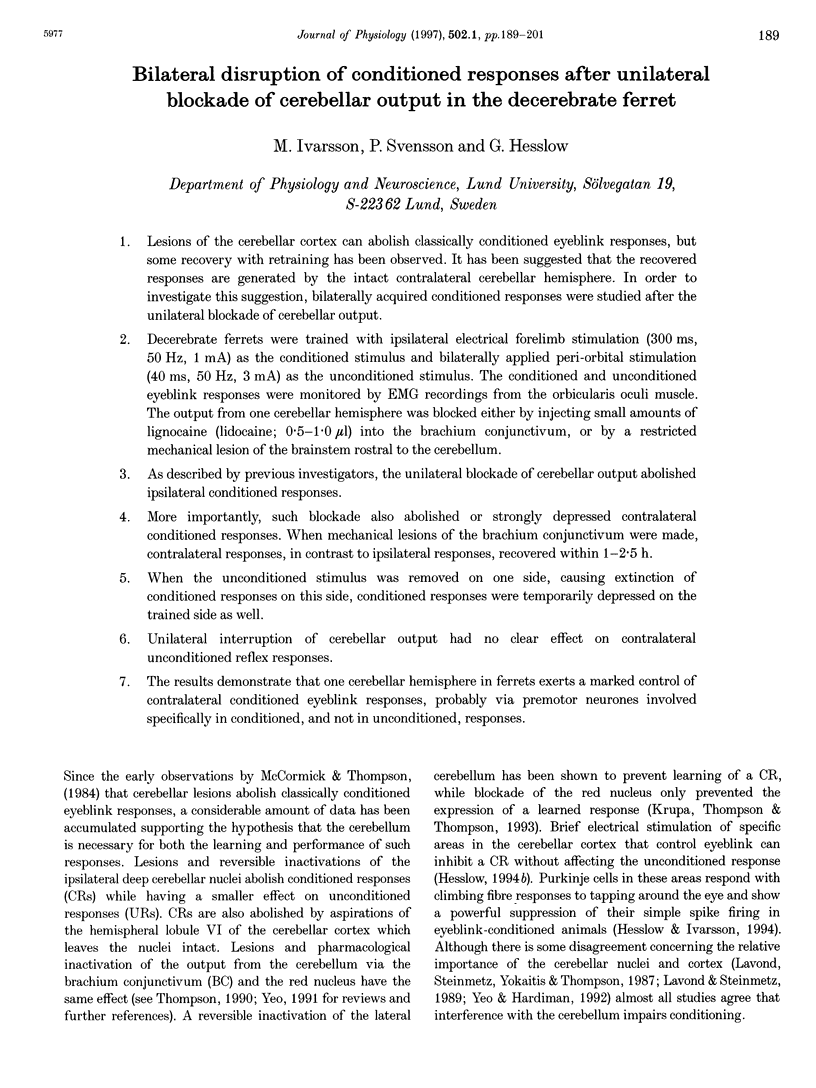
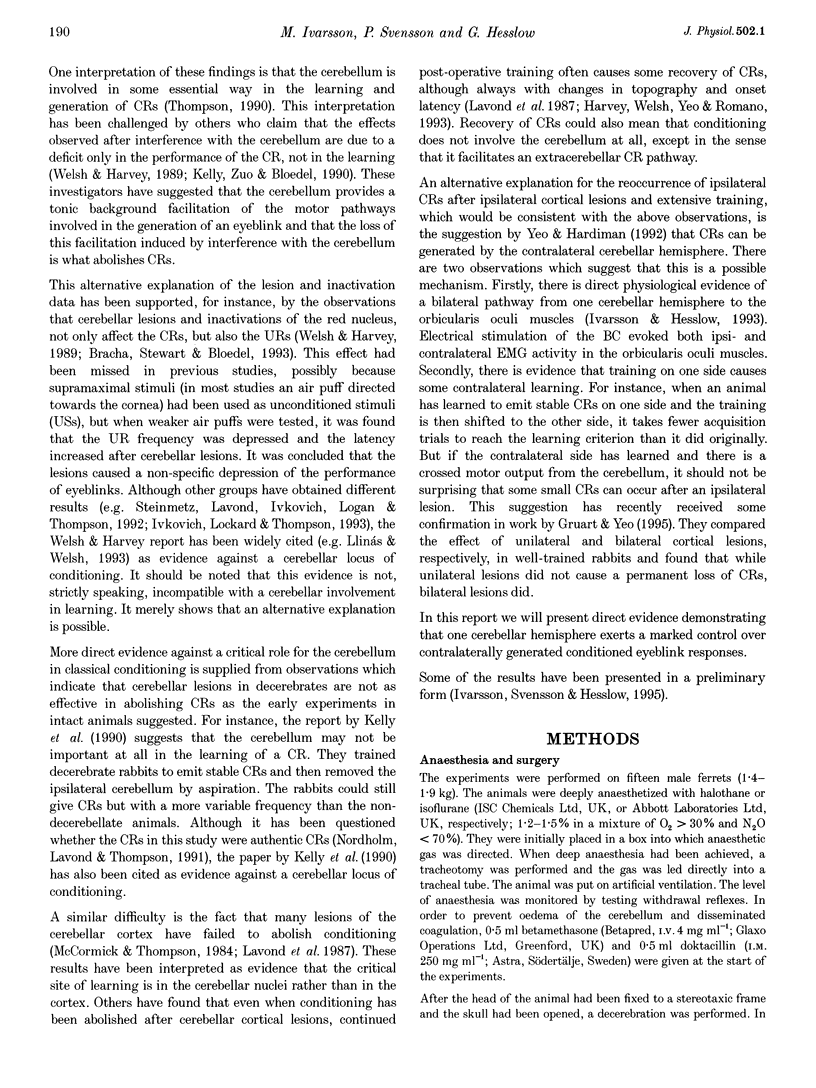
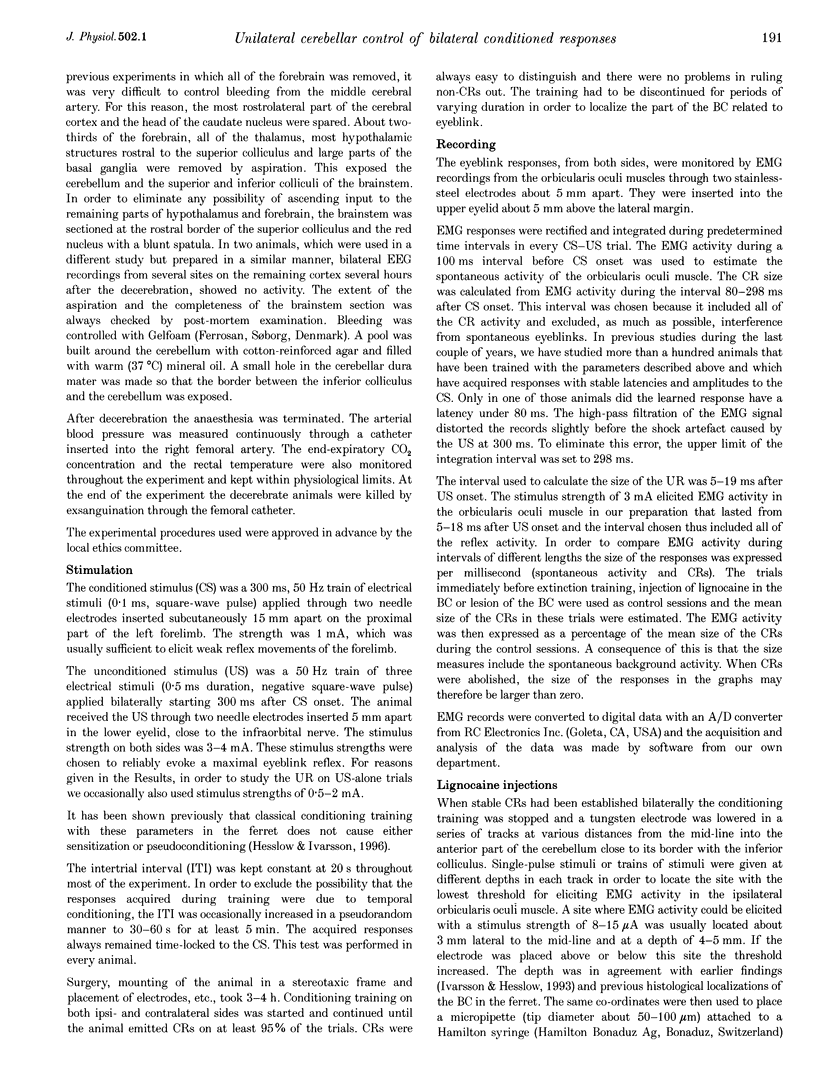
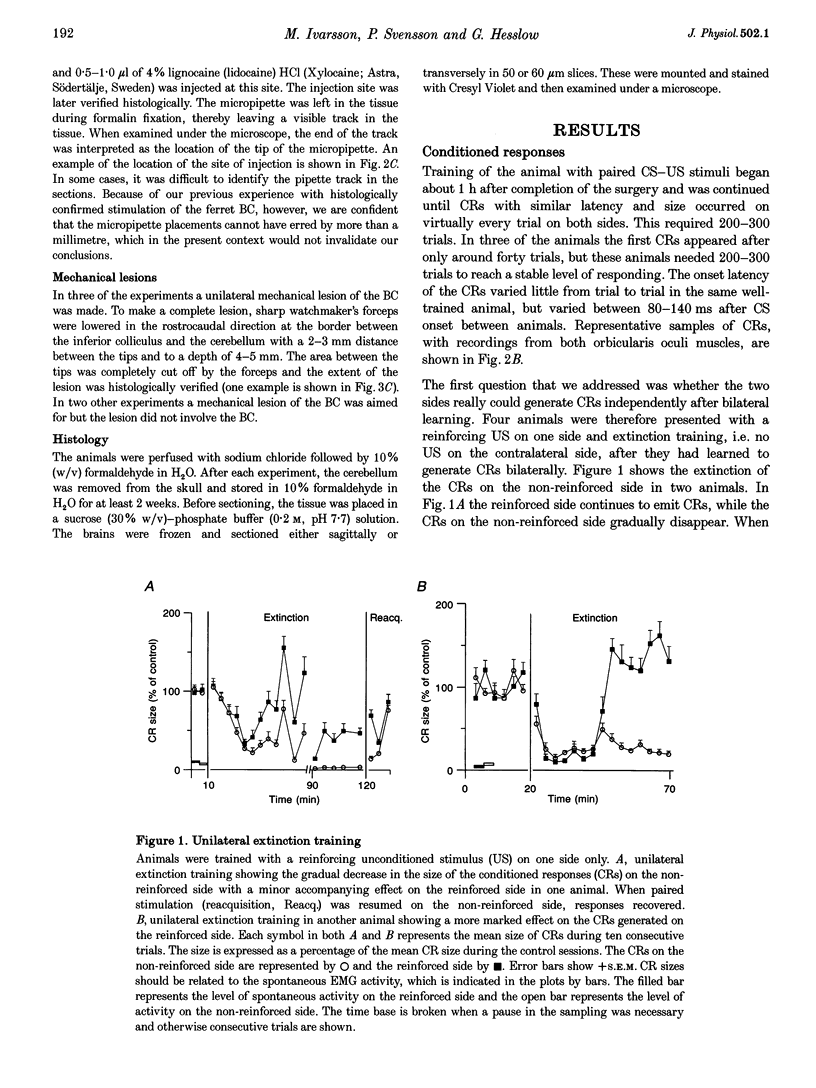
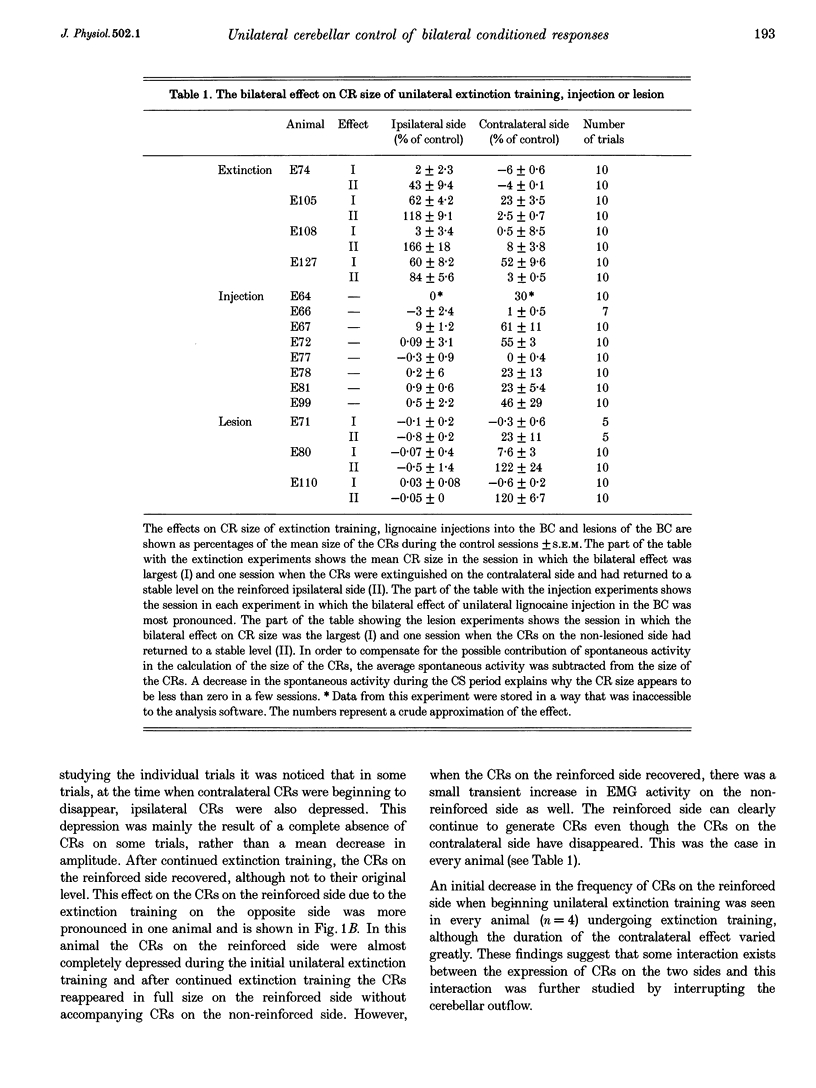
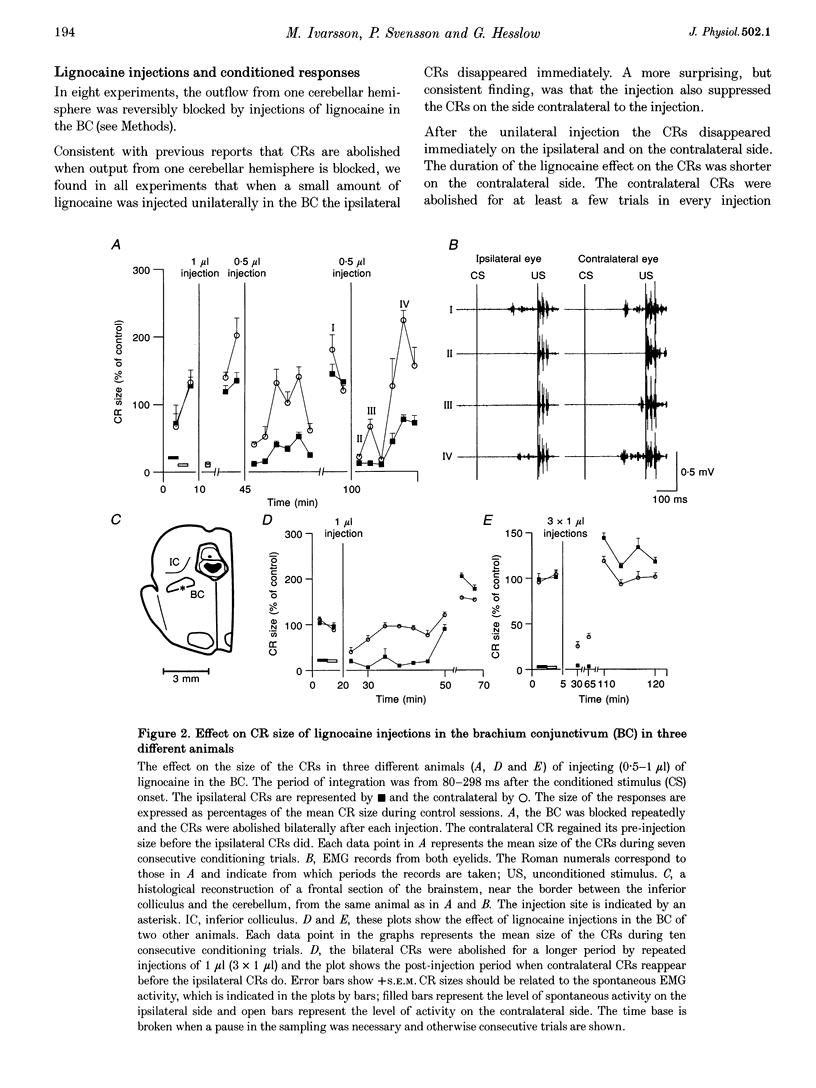
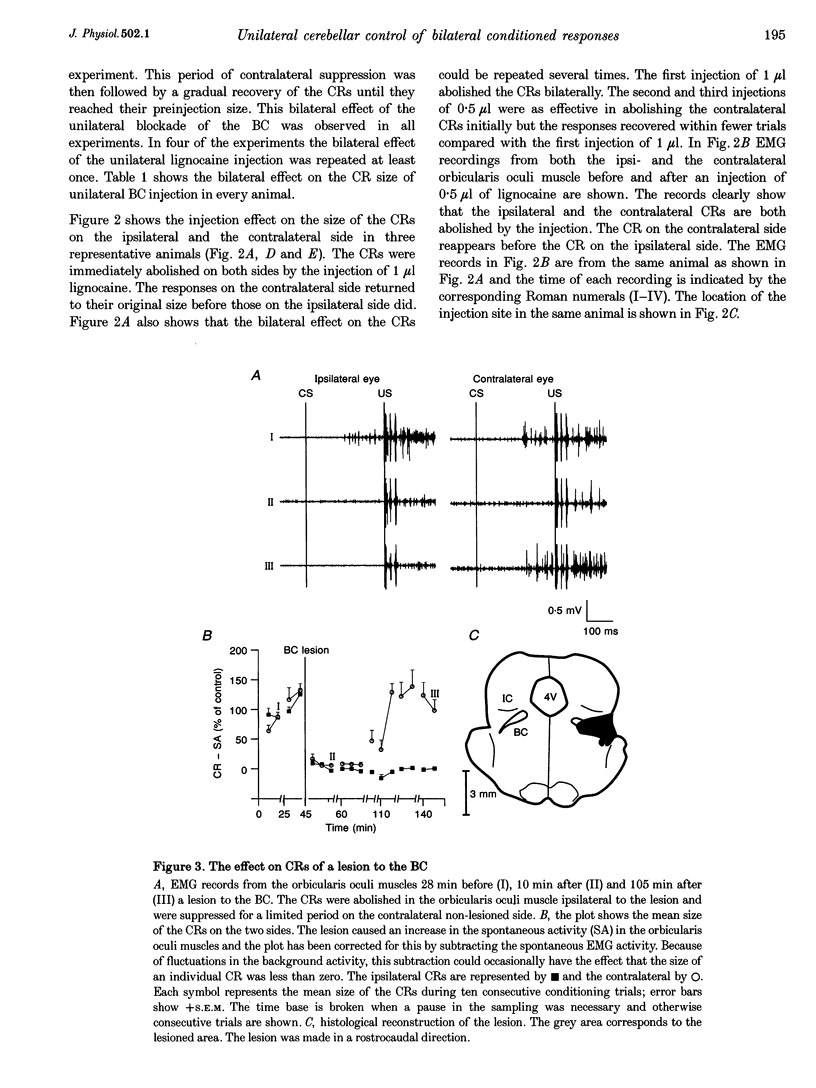
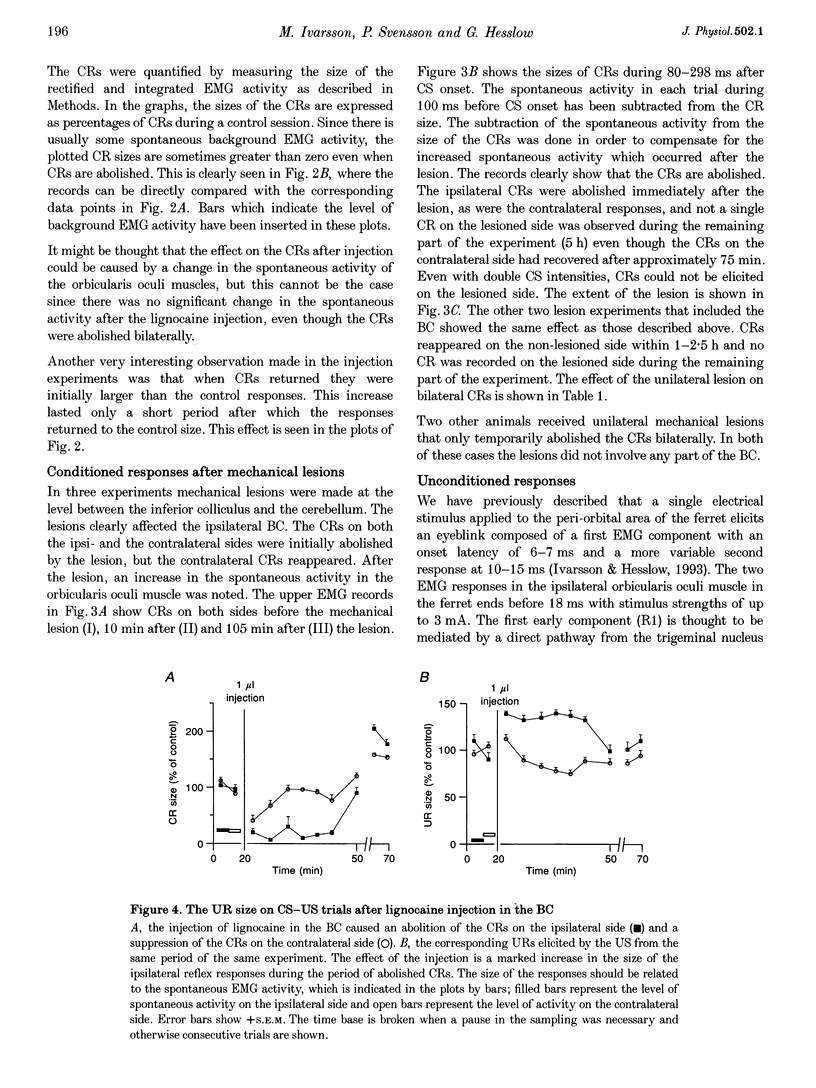
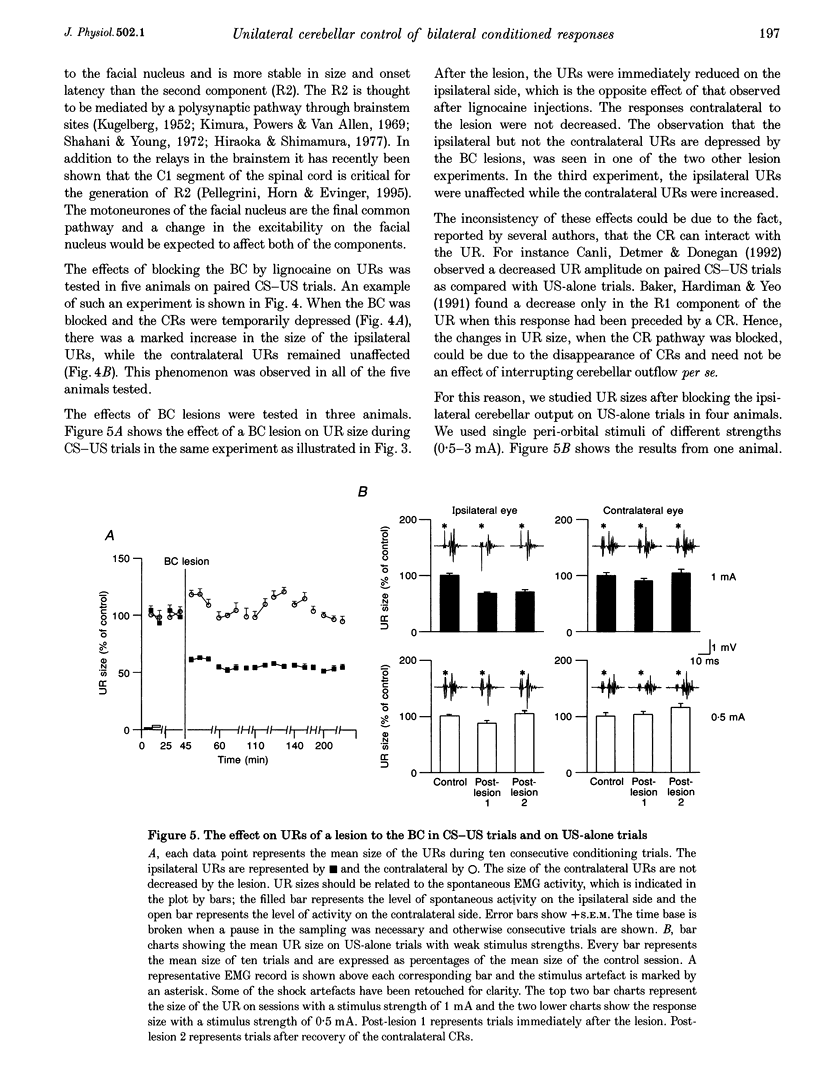
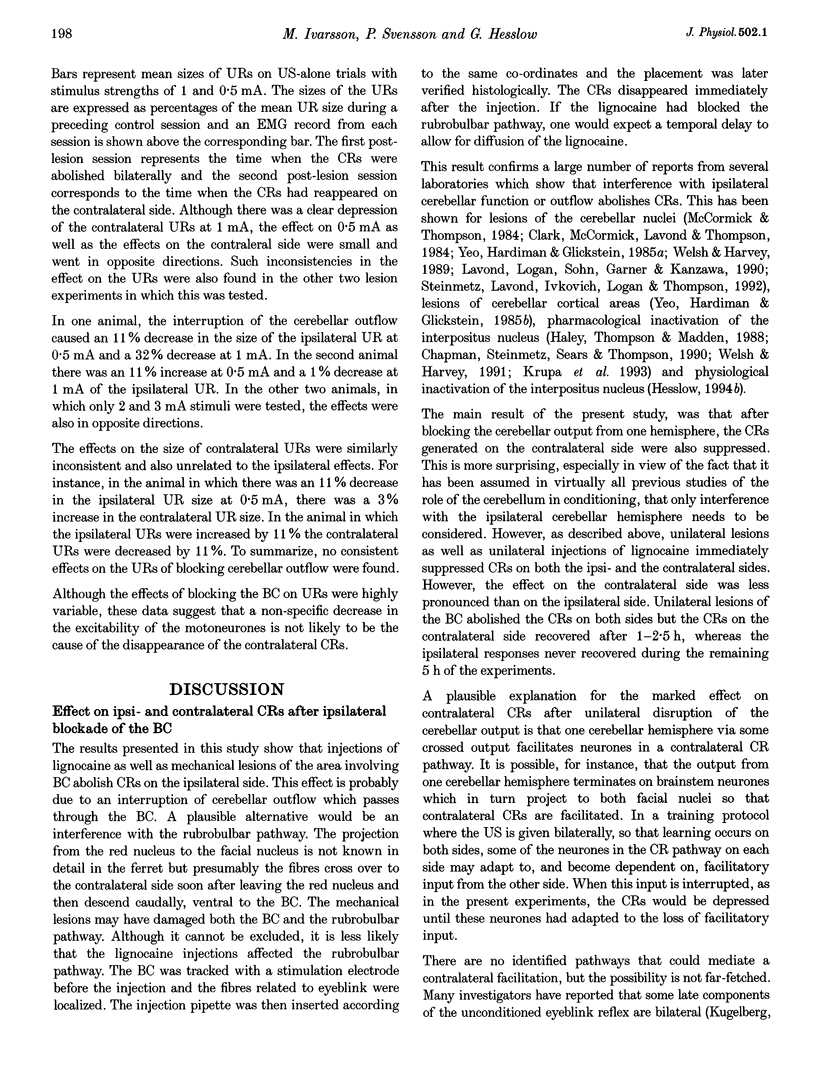
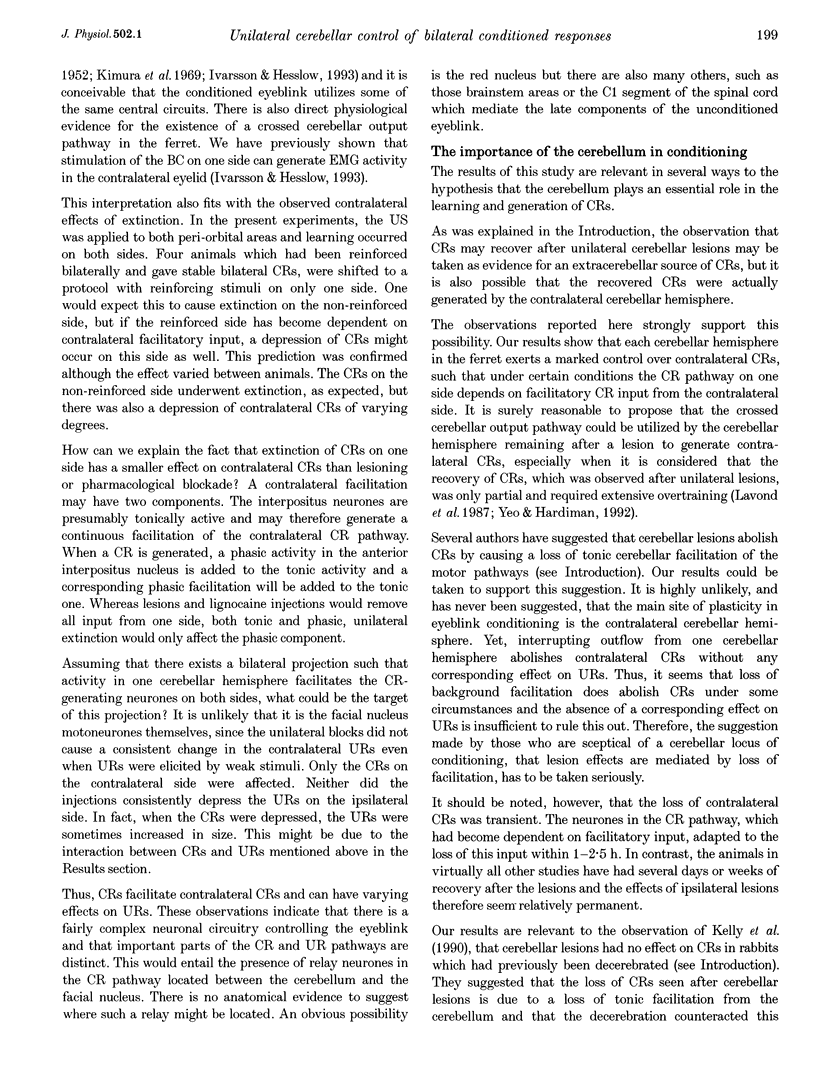
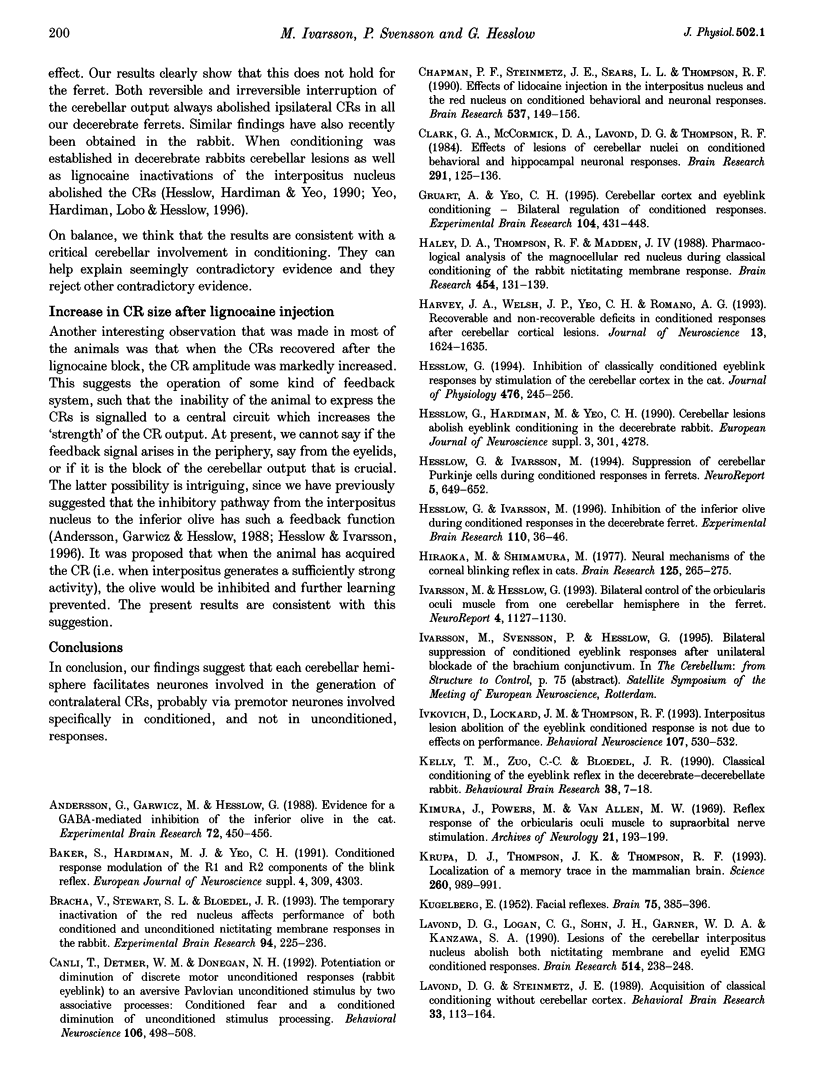
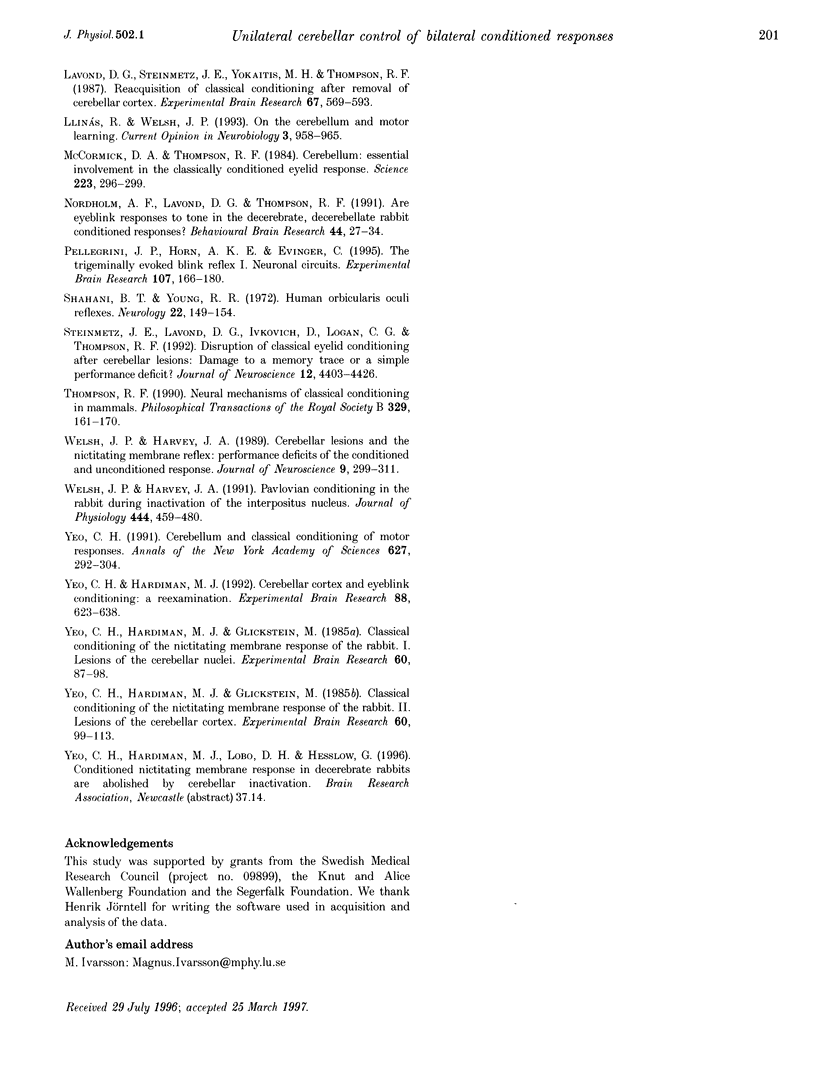
Selected References
These references are in PubMed. This may not be the complete list of references from this article.
- Andersson G., Garwicz M., Hesslow G. Evidence for a GABA-mediated cerebellar inhibition of the inferior olive in the cat. Exp Brain Res. 1988;72(3):450–456. doi: 10.1007/BF00250590. [DOI] [PubMed] [Google Scholar]
- Bracha V., Stewart S. L., Bloedel J. R. The temporary inactivation of the red nucleus affects performance of both conditioned and unconditioned nictitating membrane responses in the rabbit. Exp Brain Res. 1993;94(2):225–236. doi: 10.1007/BF00230290. [DOI] [PubMed] [Google Scholar]
- Canli T., Detmer W. M., Donegan N. H. Potentiation or diminution of discrete motor unconditioned responses (rabbit eyeblink) to an aversive pavlovian unconditioned stimulus by two associative processes: conditioned fear and a conditioned diminution of unconditioned stimulus processing. Behav Neurosci. 1992 Jun;106(3):498–508. doi: 10.1037//0735-7044.106.3.498. [DOI] [PubMed] [Google Scholar]
- Chapman P. F., Steinmetz J. E., Sears L. L., Thompson R. F. Effects of lidocaine injection in the interpositus nucleus and red nucleus on conditioned behavioral and neuronal responses. Brain Res. 1990 Dec 24;537(1-2):149–156. doi: 10.1016/0006-8993(90)90351-b. [DOI] [PubMed] [Google Scholar]
- Clark G. A., McCormick D. A., Lavond D. G., Thompson R. F. Effects of lesions of cerebellar nuclei on conditioned behavioral and hippocampal neuronal responses. Brain Res. 1984 Jan 16;291(1):125–136. doi: 10.1016/0006-8993(84)90658-9. [DOI] [PubMed] [Google Scholar]
- Gruart A., Yeo C. H. Cerebellar cortex and eyeblink conditioning: bilateral regulation of conditioned responses. Exp Brain Res. 1995;104(3):431–448. doi: 10.1007/BF00231978. [DOI] [PubMed] [Google Scholar]
- Haley D. A., Thompson R. F., Madden J., 4th Pharmacological analysis of the magnocellular red nucleus during classical conditioning of the rabbit nictitating membrane response. Brain Res. 1988 Jun 28;454(1-2):131–139. doi: 10.1016/0006-8993(88)90811-6. [DOI] [PubMed] [Google Scholar]
- Harvey J. A., Welsh J. P., Yeo C. H., Romano A. G. Recoverable and nonrecoverable deficits in conditioned responses after cerebellar cortical lesions. J Neurosci. 1993 Apr;13(4):1624–1635. doi: 10.1523/JNEUROSCI.13-04-01624.1993. [DOI] [PMC free article] [PubMed] [Google Scholar]
- Hesslow G. Inhibition of classically conditioned eyeblink responses by stimulation of the cerebellar cortex in the decerebrate cat. J Physiol. 1994 Apr 15;476(2):245–256. doi: 10.1113/jphysiol.1994.sp020127. [DOI] [PMC free article] [PubMed] [Google Scholar]
- Hesslow G., Ivarsson M. Inhibition of the inferior olive during conditioned responses in the decerebrate ferret. Exp Brain Res. 1996 Jun;110(1):36–46. doi: 10.1007/BF00241372. [DOI] [PubMed] [Google Scholar]
- Hesslow G., Ivarsson M. Suppression of cerebellar Purkinje cells during conditioned responses in ferrets. Neuroreport. 1994 Jan 31;5(5):649–652. doi: 10.1097/00001756-199401000-00030. [DOI] [PubMed] [Google Scholar]
- Hiraoka M., Shimamura M. Neural mechanisms of the corneal blinking reflex in cats. Brain Res. 1977 Apr 15;125(2):265–275. doi: 10.1016/0006-8993(77)90620-5. [DOI] [PubMed] [Google Scholar]
- Ivarsson M., Hesslow G. Bilateral control of the orbicularis oculi muscle by one cerebellar hemisphere in the ferret. Neuroreport. 1993 Sep;4(9):1127–1130. [PubMed] [Google Scholar]
- Ivkovich D., Lockard J. M., Thompson R. F. Interpositus lesion abolition of the eyeblink conditioned response is not due to effects on performance. Behav Neurosci. 1993 Jun;107(3):530–532. doi: 10.1037//0735-7044.107.3.530. [DOI] [PubMed] [Google Scholar]
- KUGELBERG E. [Facial reflexes]. Brain. 1952 Sep;75(3):385–396. doi: 10.1093/brain/75.3.385. [DOI] [PubMed] [Google Scholar]
- Kelly T. M., Zuo C. C., Bloedel J. R. Classical conditioning of the eyeblink reflex in the decerebrate-decerebellate rabbit. Behav Brain Res. 1990 Apr 16;38(1):7–18. doi: 10.1016/0166-4328(90)90019-b. [DOI] [PubMed] [Google Scholar]
- Kimura J., Powers J. M., Van Allen M. W. Reflex response of orbicularis oculi muscle to supraorbital nerve stimulation. Study in normal subjects and in peripheral facial paresis. Arch Neurol. 1969 Aug;21(2):193–199. doi: 10.1001/archneur.1969.00480140093009. [DOI] [PubMed] [Google Scholar]
- Krupa D. J., Thompson J. K., Thompson R. F. Localization of a memory trace in the mammalian brain. Science. 1993 May 14;260(5110):989–991. doi: 10.1126/science.8493536. [DOI] [PubMed] [Google Scholar]
- Lavond D. G., Logan C. G., Sohn J. H., Garner W. D., Kanzawa S. A. Lesions of the cerebellar interpositus nucleus abolish both nictitating membrane and eyelid EMG conditioned responses. Brain Res. 1990 Apr 30;514(2):238–248. doi: 10.1016/0006-8993(90)91419-h. [DOI] [PubMed] [Google Scholar]
- Lavond D. G., Steinmetz J. E. Acquisition of classical conditioning without cerebellar cortex. Behav Brain Res. 1989 Jun 1;33(2):113–164. doi: 10.1016/s0166-4328(89)80047-6. [DOI] [PubMed] [Google Scholar]
- Lavond D. G., Steinmetz J. E., Yokaitis M. H., Thompson R. F. Reacquisition of classical conditioning after removal of cerebellar cortex. Exp Brain Res. 1987;67(3):569–593. doi: 10.1007/BF00247289. [DOI] [PubMed] [Google Scholar]
- Llinás R., Welsh J. P. On the cerebellum and motor learning. Curr Opin Neurobiol. 1993 Dec;3(6):958–965. doi: 10.1016/0959-4388(93)90168-x. [DOI] [PubMed] [Google Scholar]
- McCormick D. A., Thompson R. F. Cerebellum: essential involvement in the classically conditioned eyelid response. Science. 1984 Jan 20;223(4633):296–299. doi: 10.1126/science.6701513. [DOI] [PubMed] [Google Scholar]
- Nordholm A. F., Lavond D. G., Thompson R. F. Are eyeblink responses to tone in the decerebrate, decerebellate rabbit conditioned responses? Behav Brain Res. 1991 Jul 1;44(1):27–34. doi: 10.1016/s0166-4328(05)80236-0. [DOI] [PubMed] [Google Scholar]
- Pellegrini J. J., Horn A. K., Evinger C. The trigeminally evoked blink reflex. I. Neuronal circuits. Exp Brain Res. 1995;107(2):166–180. doi: 10.1007/BF00230039. [DOI] [PubMed] [Google Scholar]
- Shahani B. T., Young R. R. Human orbicularis oculi reflexes. Neurology. 1972 Feb;22(2):149–154. doi: 10.1212/wnl.22.2.149. [DOI] [PubMed] [Google Scholar]
- Steinmetz J. E., Lavond D. G., Ivkovich D., Logan C. G., Thompson R. F. Disruption of classical eyelid conditioning after cerebellar lesions: damage to a memory trace system or a simple performance deficit? J Neurosci. 1992 Nov;12(11):4403–4426. doi: 10.1523/JNEUROSCI.12-11-04403.1992. [DOI] [PMC free article] [PubMed] [Google Scholar]
- Thompson R. F. Neural mechanisms of classical conditioning in mammals. Philos Trans R Soc Lond B Biol Sci. 1990 Aug 29;329(1253):161–170. doi: 10.1098/rstb.1990.0161. [DOI] [PubMed] [Google Scholar]
- Welsh J. P., Harvey J. A. Cerebellar lesions and the nictitating membrane reflex: performance deficits of the conditioned and unconditioned response. J Neurosci. 1989 Jan;9(1):299–311. doi: 10.1523/JNEUROSCI.09-01-00299.1989. [DOI] [PMC free article] [PubMed] [Google Scholar]
- Welsh J. P., Harvey J. A. Pavlovian conditioning in the rabbit during inactivation of the interpositus nucleus. J Physiol. 1991 Dec;444:459–480. doi: 10.1113/jphysiol.1991.sp018888. [DOI] [PMC free article] [PubMed] [Google Scholar]
- Yeo C. H. Cerebellum and classical conditioning of motor responses. Ann N Y Acad Sci. 1991;627:292–304. doi: 10.1111/j.1749-6632.1991.tb25933.x. [DOI] [PubMed] [Google Scholar]
- Yeo C. H., Hardiman M. J. Cerebellar cortex and eyeblink conditioning: a reexamination. Exp Brain Res. 1992;88(3):623–638. doi: 10.1007/BF00228191. [DOI] [PubMed] [Google Scholar]
- Yeo C. H., Hardiman M. J., Glickstein M. Classical conditioning of the nictitating membrane response of the rabbit. I. Lesions of the cerebellar nuclei. Exp Brain Res. 1985;60(1):87–98. doi: 10.1007/BF00237022. [DOI] [PubMed] [Google Scholar]
- Yeo C. H., Hardiman M. J., Glickstein M. Classical conditioning of the nictitating membrane response of the rabbit. II. Lesions of the cerebellar cortex. Exp Brain Res. 1985;60(1):99–113. doi: 10.1007/BF00237023. [DOI] [PubMed] [Google Scholar]


